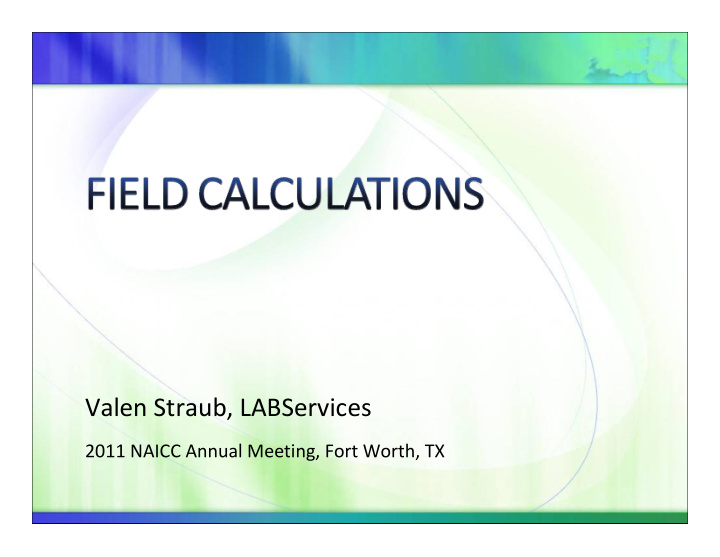



Valen Straub, LABServices 2011 NAICC Annual Meeting, Fort Worth, TX
Field Calculations Field Calculations Where do we start? Read the Protocol Wealth of information Test substance Application Plot size formulation equipment Application rate Adjuvant Spray volume
Field Calculations Field Calculations Test substance formulation X ‐ 2009 0.4 EC 0.4 0.4 1 gallon contains 0.4 pounds of ai (active ingredient) (or 48 grams of ai in 1 liter) EC (Emulsifiable Concentrate) First indication that you are dealing with a liquid
Field Calculations Field Calculations How do I know 0.4 pounds ai in 1 gallon equal 48 grams ai in 1 liter Do the math… Long way: 0.4 lb 454 grams /lb 181.6 grams 1 gallon 3.785 liters/gallon 3.785 liters 181.6 grams/3.785 liter N / 1 liter 48 grams / 1 liter Shortcut: 0.4 120 (constant) 48
Field Calculations Field Calculations Plot size One untreated control (UTC) plot and treated plot(s) Treated plots in tree studies will consist of a block of 6 consecutive trees Applications will be made to both sides of the row
Field Calculations Field Calculations Application equipment Air blast sprayer
Field Calculations Field Calculations Application rate 18.14 grams ai (active ingredient)/A) or (0.04 lb ai/A)
Field Calculations Field Calculations Typically there are several ways that application rates may be listed: Amount of active ingredient per unit of area or per volume of mixture (In our case 18 grams ai/A or 0.04 lb ai/A) Amount of formulation per unit of area or per unit of volume (lb fp/A) Amount of formulation per volume of mixture (pint/100 gallons of water) Percentage of final dilution (% by volume or % by weight)
Field Calculations Field Calculations Adjuvant No Crop Oil needed Test substance will be applied alone
Field Calculations Field Calculations Spray volume 100 GPA (gallons per acre) Why is this information needed? This is standard by which we need to calibrate the airblast sprayer Calibration is how the airblast sprayer output is adjusted to reach the desired GPA In our case 100 GPA, (+/ ‐ 5%) as per protocol requirement
Field Calculations Field Calculations Are we ready to do the math now? Not quite…
First order of business is to check the test plot If time permits, run a tape measure and check plot length and width If you don’t have the time to measure, check the plot map carefully and make sure what you see listed on the map is what you see in the field
Step 1: Determine your Plot Area Plot Width (ft) X Plot length (ft) of a treated area = Plot Area to be sprayed (ft. sq.) In our case, 20 ft 75 ft 1500 ft. sq. 1500 ft. sq. 43560 ft. sq. /Acre 0.034 Acres Estimate mix size based on protocol GPA (100 GPA) 0.034 A 100 GPA 3.4 gallons (minimum mix size) PI uses 5 gallons to calibrate equipment
Step 1: Fill in the information on your calculation sheet 20 ft 75 ft 1500 ft. sq 1500 ft. sq. 0.034 A
Pre ‐ calibration inspection (what the PI should be looking at and QA should be aware of): The spray tanks are clean All hoses and fittings are sound All screen and nozzles are clean Tire pressure on the tractor is correct Start the pump and set the tractor engine speed to the desired rpm
Pre ‐ calibration inspection, continued : Open the manifold valve to fill the lines and begin spraying Adjust the pressure regulator and obtain the desired operating pressure Check that each nozzle shut ‐ off valve is working Check that the agitation system is functioning properly Search for and correct any leaks Adjust the air stream, if needed
Step 2: Calibrate the airblast sprayer Check SOP is available and accurate Read the SOP so you are familiar with the calibration process Calibrate the sprayer in an area that is representative of the plot area that will be sprayed. Never calibrate a sprayer on a hard surface (such as pavement) which can induce errors as high as 15% compared to the field site The location of the where the calibration spray flags are placed should be equal to the terrain in the treated area
Step 2: Calibrate the airblast sprayer, continued The airblast sprayer is filled with the correct amount of water and is ready for the start of the calibration spray runs From the calibration worksheet ‐ 5 gallons (18925 mls) is the amount of water being used for each calibration run
Step 2: Calibrate the airblast sprayer, continued What should you be looking for: Closely watch the shut ‐ off times and make sure the person timing the spray passes between the spray flags, starts and stops and the same location Sprays should mimic actual spray Protocol requires two sides of the tree to be sprayed Spraying both sides of the tree is referred to as a full cover spray in commercial applications. Is this being done in the calibration run?
Step 3: Field Calculations It’s time to do some math!!! Why is it important to apply the correct amount of X ‐ 2009 0.4 EC to the trial plot area? If you apply too little pesticide you may not be fully controlling the pest If you apply too much pesticide you may cause damage or injuries, leave illegal residues, and you can be fined or liable for damages
Step 3: Field Calculations, continued 101.16 382.89 101 3.44 0.034 0.034 13.02 0.034 3.44 4.3 13.02 16.3
Step 3: Field Calculations, continued X ‐ 2009 0.4 EC 0.04 0.4 0.4 0.4
Step 3: Field Calculations, continued 0.4 0.04 378.5 378.5 16.11 16.3 4.3 382.89 16.3
Valen Straub, LABServices 2011 NAICC Annual Meeting, Fort Worth, TX
Recommend
More recommend